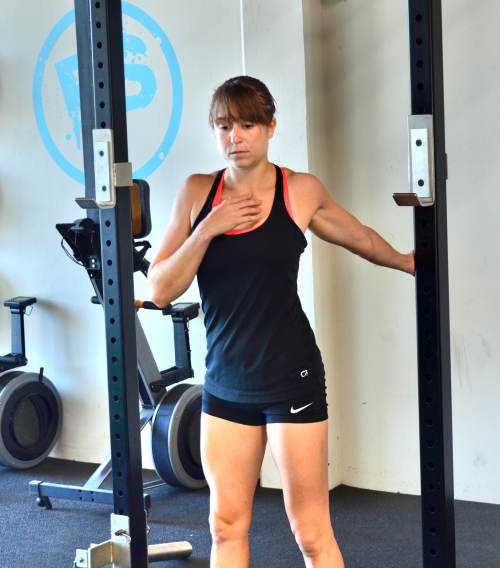WARM UP
Stretch and Roll Out:
Wrists/Forearms
Chest
Shoulders
Traps
WORKOUT
Complete as many rounds of the circuit below as you can in 10 minutes. Try to rest as little as possible and move straight from one exercise to another.
CIRCUIT:
8-12 reps each side Alternating Overhead Dumbbell Presses
5-15 reps Dips
2-10 reps each side Standing Chest Stretch
CONDITIONING:
The Push Up Burnout (up to 5 minutes)- As many push ups as possible before complete failure.
This is almost like a drop set for push ups. Force out as many push ups as you can without resting. What this means is you will have to set up regressions. If you can do push ups from your toes, you will want to start there. When you hit failure or would need to sit back and rest, instantly drop to your knees and continue. When you hit failure there or would need to rest, move your hands up to an incline and continue. When you hit failure there, move to an easier incline. Keep regressing as needed, doing push ups for up to 5 minutes. Beginners may only get about 1 or 2 minutes of push ups.
You can also have a partner assist you with push ups at each stage by helping pull you back up.
COOL DOWN
Stretch and Roll Out:
Wrists/Forearms
Chest
Shoulders
Traps
NOTES:
When you reach the pull up burn out, your chest, shoulders and triceps will already be super fatigued from the 10 minutes of upper body.
Because of the massive number of push ups, do not do this workout every week. OR make sure that you don’t do it for numerous weeks in a row.
This workout is almost a good “check up” to test your strength from your upper body routine.
EXERCISE DESCRIPTIONS:
Alternating Overhead Dumbbell Presses – Stand with your feet a few inches apart but no more than hip-width apart. Holding a dumbbell in each hand, bring your hands up to your shoulders. Keep your core tight and press straight up overhead with one hand. Fully extend the arm, but do not arch your back to press the weight overhead. Lower that weight down to your shoulder and then switch and lift the other arm overhead. Keep your core tight as you press. Do not lean as you raise the weight. As you fatigue, you may use your legs a little. To use your legs, bend the knees just slightly and then quickly stand back up, pressing the weight overhead as you do. Do not do a big squat when using your legs to help you press. Only use your legs if you truly need them.
Dips – Beginners may do an assisted variation off of dip bars or parallel bars. They may also do these off of kettlebells or a bench. Advanced exercisers will do full dips and may even add weight to challenge them. To do a full dip, place one hand on each bar. Press up to the top so that your arms are fully extended. Then slowly bend your elbows and lower your body down. You want to lower yourself down until your upper arms are parallel to the ground. Then drive back up through your hands until you are fully extended at the top. Keep your core tight so you don’t arch your low back. Do not lean too far forward. To do this move from the bench, place both hands on the bench behind you. Your finger tips should hang over the bench and face you. Stretch your legs out then in front of you. The straighter your legs are and the further your heels are from your butt, the harder the move will be. Bend your elbows and drop your butt toward the ground. Drop so your upper arms are parallel to the ground then press back up. Keep your butt and back right up agains the bench. Do not let your body drift forward.

Standing Chest Stretch – Using a door or wall, place one hand back on the wall or doorway and turn away from the hand on the wall or door. You should feel a nice stretch on that side of your chest.

Push Ups – Beginners will do either an incline push up with their hands up on a bench or a push up from their knees. Advanced exercisers will do a push up from their hands and toes. For any variation, start by lying on the ground with your legs together. Place your hands outside your chest. Draw your belly button in toward your spine and squeeze your glutes. If doing this move from your toes, you will then press up onto your hands and toes. Your body should move in one straight line. Everything should move together as you press up to the top of the push up with the arms full extended. Do not let your butt go up in the air or your hips sag toward the ground. Do not tuck your chin. Keep your head in line with your spine. Make sure to keep your core tight so your low back doesn’t arch. Then lower back down, making sure your body moves as one unit. Touch your chest to the ground and then lift right back up. If your body doesn’t move together, if you do the “worm” as you press up or down, regress to your knees or an incline push up.
